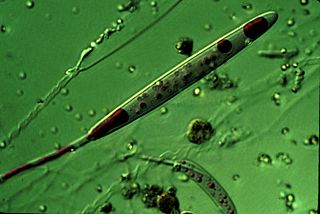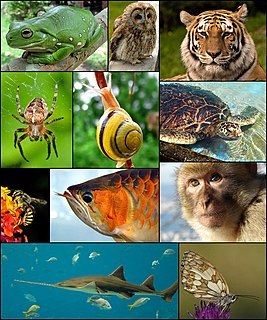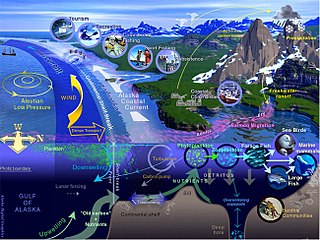
Cnidaria is a phylum under kingdom Animalia containing over 11,000 species of aquatic animals found both in freshwater and marine environments, predominantly the latter.

The flatworms, flat worms, Platyhelminthes, or platyhelminths are a phylum of relatively simple bilaterian, unsegmented, soft-bodied invertebrates. Unlike other bilaterians, they are acoelomates, and have no specialized circulatory and respiratory organs, which restricts them to having flattened shapes that allow oxygen and nutrients to pass through their bodies by diffusion. The digestive cavity has only one opening for both ingestion and egestion ; as a result, the food cannot be processed continuously.

A cnidocyte is an explosive cell containing one giant secretory organelle called a cnidocyst that can deliver a sting to other organisms. The presence of this cell defines the phylum Cnidaria. Cnidae are used to capture prey and as a defense against predators. A cnidocyte fires a structure that contains a toxin within the cnidocyst; this is responsible for the stings delivered by a cnidarian.

The Bilateria or bilaterians are animals with bilateral symmetry as an embryo, i.e. having a left and a right side that are mirror images of each other. This also means they have a head and a tail as well as a belly and a back. Nearly all are bilaterally symmetrical as adults as well; the most notable exception is the echinoderms, which achieve secondary pentaradial symmetry as adults, but are bilaterally symmetrical during embryonic development.

Ctenophora comprise a phylum of marine invertebrates, commonly known as comb jellies, that inhabit sea waters worldwide. They are notable for the groups of cilia they use for swimming, and they are the largest animals to swim with the help of cilia.

Myxozoa is an unranked subphylum of aquatic, obligately parasitic cnidarian animals and contains the smallest animals ever known to have lived. Over 2180 species have been described and some estimates have suggested at least 30,000 undiscovered species. Many have a two-host lifecycle, involving a fish and an annelid worm or a bryozoan. The average size of a myxosporean spore usually ranges from 10 μm to 20 μm, whereas that of a malacosporean spore can be up to 2 mm. Myxozoans can live in both freshwater and marine habitats.

A nerve net consists of interconnected neurons lacking a brain or any form of cephalization. While organisms with bilateral body symmetry are normally associated with a central nervous system, organisms with radial symmetry are associated with nerve nets. Nerve nets can be found in members of the Cnidaria, Ctenophora, and Echinodermata phyla, all of which are found in marine environments. Nerve nets can provide animals with the ability to sense objects through the use of the sensory neurons within the nerve net.

Kimberella is an extinct genus of bilaterian known only from rocks of the Ediacaran period. The slug-like organism fed by scratching the microbial surface on which it dwelt in a manner similar to the gastropods, although its affinity with this group is contentious.

A muscle cell is also known as a myocyte when referring to either a cardiac muscle cell (cardiomyocyte), or a smooth muscle cell as these are both small cells. A skeletal muscle cell is long and threadlike with many nuclei and is called a muscle fiber. Muscle cells develop from embryonic precursor cells called myoblasts.

Symmetry in biology refers to the symmetry observed in organisms, including plants, animals, fungi, and bacteria. External symmetry can be easily seen by just looking at an organism. For example, take the face of a human being which has a plane of symmetry down its centre, or a pine cone with a clear symmetrical spiral pattern. Internal features can also show symmetry, for example the tubes in the human body which are cylindrical and have several planes of symmetry.
Tetracapsuloides bryosalmonae is a myxozoan parasite of salmonid fish. It is the only species currently recognized in the monotypic genus Tetracapsuloides. It is the cause of proliferative kidney disease (PKD), one of the most serious parasitic diseases of salmonid populations in Europe and North America that can result in losses of up to 90% in infected populations.

Marine life, sea life, or ocean life is the plants, animals, and other organisms that live in the salt water of the sea or ocean, or the brackish water of coastal estuaries. At a fundamental level, marine life affects the nature of the planet. Marine organisms, mostly microorganisms, produce oxygen and sequester carbon. Marine life in part shape and protect shorelines, and some marine organisms even help create new land. Most life forms evolved initially in marine habitats. By volume, oceans provide about 90% of the living space on the planet. The earliest vertebrates appeared in the form of fish, which live exclusively in water. Some of these evolved into amphibians, which spend portions of their lives in water and portions on land. Other fish evolved into land mammals and subsequently returned to the ocean as seals, dolphins, or whales. Plant forms such as kelp and other algae grow in the water and are the basis for some underwater ecosystems. Plankton forms the general foundation of the ocean food chain, particularly phytoplankton which are key primary producers.

Medusozoa is a clade in the phylum Cnidaria, and is often considered a subphylum. It includes the classes Hydrozoa, Scyphozoa, Staurozoa and Cubozoa, and possibly the parasitic Polypodiozoa. Medusozoans are distinguished by having a medusa stage in their often complex life cycle, a medusa typically being an umbrella-shaped body with stinging tentacles around the edge. With the exception of some Hydrozoa, all are called jellyfish in their free-swimming medusa phase.

Marine invertebrates are the invertebrates that live in marine habitats. Invertebrate is a blanket term that includes all animals apart from the vertebrate members of the chordate phylum. Invertebrates lack a vertebral column, and some have evolved a shell or a hard exoskeleton. As on land and in the air, marine invertebrates have a large variety of body plans, and have been categorised into over 30 phyla. They make up most of the macroscopic life in the oceans.
The Cambrian explosion or Cambrian radiation was an event approximately 541 million years ago in the Cambrian period when practically all major animal phyla started appearing in the fossil record. It lasted for about 13 – 25 million years and resulted in the divergence of most modern metazoan phyla. The event was accompanied by major diversifications in other groups of organisms as well.

Nephrozoa is a major clade of bilaterians, divided into the protostomes and the deuterostomes, containing almost all animal phyla and over a million extant species. Its sister clade is the Xenacoelomorpha. The Ambulacraria was formerly thought to be sister to the Xenacoelomorpha, forming the Xenambulacraria as basal Deuterostomes, or basal Bilateria invalidating Nephrozoa and Deuterostomes in earlier studies. The coelom, the digestive tract and excretory organs, and nerve cords developed in the Nephrozoa. It has been argued that, because protonephridia are only found in protostomes, they cannot be considered a synapomorphy of this group. This would make Nephrozoa an improper name, leaving Eubilateria as this clade's name.
The evolution of nervous systems dates back to the first development of nervous systems in animals. Neurons developed as specialized electrical signaling cells in multicellular animals, adapting the mechanism of action potentials present in motile single-celled and colonial eukaryotes. Many primitive systems, like those found in complex protozoa, use non-electrical signaling for motility and other aspects necessary for survival. Data suggests that these systems, which use a chemical gradient for messaging, evolved into the electrical-signaling cells known today.

ParaHoxozoa is a clade of animals that consists of Bilateria, Placozoa, and Cnidaria. The relationship of this clade relative to the two other animal lineages Ctenophora and Porifera is debated. Some phylogenomic studies have presented evidence supporting Ctenophora as the sister to Parahoxozoa and Porifera as the sister group to the rest of animals. Some studies have presented evidence supporting Porifera as the sister to Parahoxozoa and Ctenophora as the sister group to the rest of animals. The tree below, which is congruent with the vast majority of these phylogenomic studies, conveys this uncertainty with a polytomy.
Saccosporidae is a family of myxozoans. It is the only family within the class Malacosporea and has only three species, while the other class of Myxozoa, Myxosporea, includes more than a thousand.

Polypodium is a genus of cnidarians that parasitizes in the eggs of sturgeon and similar fishes. It is one of the few metazoans (animals) that live inside the cells of other animals.














